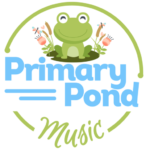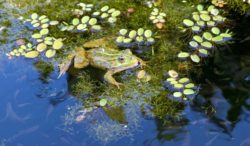(If you haven’t already seen Chrome Music Labs, go there right now, play around a bit then come back and read the rest of this post!)
For Music In Our Schools Month, Google created this wonderful new site called Chrome Music Labs. I found out about it one day last week before work, and knew I had to throw out my lesson plans and explore this with my kiddos. I am a HUGE fan of technology in the music class, and am always looking for new ways to incorporate tech into my lessons. However, I know that not all music teachers share my enthusiasm for technology, so I thought I’d share the lesson I did using Chrome Music Labs to help inspire others to try using technology in their classes.
For this lesson, I used a MacBook Pro connected to a projector and external speaker. You could also use an iPad and Apple TV but I found that any of these applications that required a microphone didn’t work on the iPad.
I started asking the kids about waves. We are really lucky to have a great wave pool down the street from our school, and most of the kids had recently gone there for swimming lesson field trips. We also are located near the beach 🙂 I asked the kids if they had ever played in waves or made waves in the bathtub. All their hands shot up, and I exclaimed, “Great! You are all experts on waves!” I told them that today, we weren’t going to learn music, instead, we were going to use music to explore science.
I then showed them the Oscillators app. Starting with the sine wave (the cute blue circle), I clicked on him quickly, and asked students what they saw (waves). I clicked on the circle again, and this time, as I clicked, I dragged the mouse down (lowering the frequency value) and asked the kids to tell me what happened. After we determined that the waves slowed down and the sound got lower. I explained that when scientists predict what will happen, we call that a ‘hypothesis,’ and asked what they hypothesized would happen if I stretched the circle up/made him taller. The kids did a quick Think/Pair/Share, and then we tested our hypothesis. Needless to say, the kids were quite excited to see that they were right: when we made the circle taller, the waves went faster and the sound got higher.
I then changed the wave shape to square (the cute little green square dude). Before clicking on it, I asked for more hypotheses, then we tested it out. We discovered that a different wave shape made a different sound, but that sound still went lower when we made the square shorter, and higher when we made it taller. We played around with the other wave shapes.
Throughout the process, I was pointing out the big ideas: Sound is made from waves. Slow waves make low sounds. Fast waves make high sounds. Different shapes make different sounds.
To assess their understanding, I went over to the Sound Waves app. I played the lowest note on the keyboard and asked them what they saw (slow waves), and asked, “What do you think will happen when I play the highest key?” (This was also a good way to reinforce left=low that I teach when playing xylophones). The kids all seemed to understand that the waves would go faster, and were so excited when they saw they were right! If you click on the little magnifying glass in the bottom right hand corner of the Sound Waves app, it will show the actual wave. We played around with that a bit.
One girl in grade 3 asked me, “What would happen if you played two notes at the same time?” Unfortunately, the app doesn’t allow for that, but I went over to the piano and played a C major chord, then played some rather inharmonic clusters, and we had a quick discussion about that. A boy in the same class said, “When you played the nice sounding notes, it was like all the waves were working together nicely, but when you played the icky notes, it was like waves crashing together and splashing all around.” Gotta love kids 🙂
After I was sure that the kids had a grasp of sound waves, we went to the Voice Spinner app. (note: this app will not record voices on the iPad) I asked the kids if they’d like to make their own sound waves (the answer was a resounding “YES!”). As we are presently getting ready for our Spring Concert, I had the students sing the first phrase of their concert song as I recorded them. Then, I moved the slider on the Voice Spinner to the right (forward), about half way. The kids were thrilled to hear themselves, but observed that it didn’t sound quite right. I pressed the mute button on my computer, and moved the slider to the far right, asking the students, “What did you notice about the spinner? What do you think your singing will sound like?” The kids were able to observe that the spinner was going faster, so that meant their singing would be going faster too. I asked “What happens to sound when we speed it up?” (“It goes higher!” was their enthusiastic response). I turned the sound back on and the kids just about lost it! They sounded so silly (“Like Alvin and the Chipmunks!”). I repeated the process as I slowed the wheel down, and again, hilarity ensued. One boy observed “We sound like big grade sevens!”
I then muted my computer again and moved the slider to the left, asking for hypotheses. Many kids thought the sound would go really slow. Only a handful were able to infer that their voices would go backwards. We listened to our backwards voices slower and faster, and there was quite a bit of laughter. (Much to my dismay, one of the class’s concert songs, when played backwards, had what sounded like a bad word in it, so I quickly recorded something else!)
With the younger classes, we spent the rest of the lesson (of which there were only a few minutes left) either playing around with recording other songs or playing around with some of the apps on the site.
With the older classes (grades 3,4 and 5), they observed that their voices still sounded like voices but in a different language. I wondered out loud, “Hmm…. what do you think a recorder would sound like backwards?” (The 4s and 5s just started their recorder unit). I recorded myself playing B A G on the recorder and played it back at a medium speed. Then, we played it backwards. The kids observed that it sounded like the same notes, but backwards (G A B instead of B A G).
I asked them, “What do you think a drum would sound like backwards?” and we experimented with a djembe. Many kids predicted it would be like the voice and the recorder: sound much the same, just backwards. The kids were surprised to hear a djembe sound played backwards sounded NOTHING like a djembe! I told them about attack and decay (which was shown so nicely by the sound waves created by the Voice Spinner). We then experimented with other instruments, making predictions based on the attack and decay we heard when I played an instrument.
Sure, I sacrificed a day of concert prep (which was 7 weeks away at this point), but it was worth it. So many of the students thanked me for teaching them science as they were leaving, and many hugs ensued. A lot of kids went home and showed their families what they learned in music class (as was evidenced when their brothers or sisters came for music the next day and were asking about it! Of course, I made sure all 17 classes I teach got a chance to experience this lesson).
Sometimes the best lessons aren’t planned. They just happen.

 Jump, Frog, Jump!
Jump, Frog, Jump!
So, what do you think ?